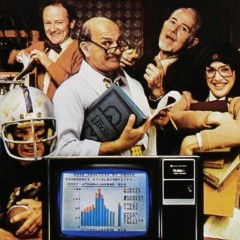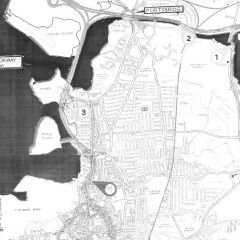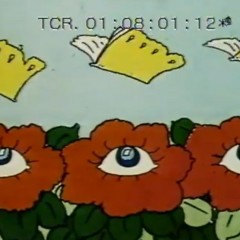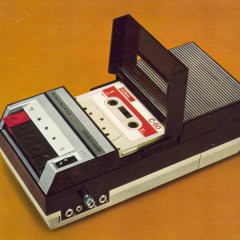Old Computer Adverts
I’ve looked at some old adverts from computer magazines before but this time I thought I’d take a look at some old adverts for computers themselves. I’m not entirely sure what sort of magazine would run an advert for a computer boasting about its ability to control missile systems but I suppose if you were buying this magazine for the computer adverts back whenever it was published you probably also had the spare barn to store the machine in and the kind of massive-barn-jealousy from others that may necessitate a ballistic defence system. Are you one of those people who think everything the Apple has ever done has been evil? Six hundred and sixty six dollars and sixty six cents! That’s the dollar value of the beast if my memory of the bible is correct. This Tandy colour computer advert brings back a lot of memories. I never had the computer itself and seeing those magic words “Cuthbert In The Mines” reminds me why. Don’t search for images of that game if you value your eyeballs. A touch-sensitive computer not much different in size from a book. We came a long way from the barn-sized Univac to the Sinclair ZX80 and we’ve come not very far since. Progress! There’s an old rule in computer advertisements: humour and kids sell. It’s a bad rule. And that’s why these computers from AMT using a child Charlie Chaplin led to the company folding with crippling losses six minutes after publication. Possibly. I haven’t checked. The Texas Instruments Home Computer gives you a tutor, an accountant, a librarian, a file clerk, and a pro football team in your own home. This wasn’t a reference to the sort of software that you could get with the computer as many people assumed but a promotion that also helped to house some of society’s most unwanted homeless people. If you’ve still got your original file clerk it could be worth a small fortune on eBay these days. Sure, a computer and acoustic coupler and monitor that fits in a briefcase sounds good but firstly the briefcase was the size of a Fiat 500, and secondly it weighed as much as a Fiat 500 overloaded with Digi-Log machines. At least it was difficult to get mugged. Sources for these images and further inspiration or adverts can be found through the following links: http://www.aresluna.org/attached/computerhistory/ads http://www.theregister.co.uk/Print/2011/04/04/osborne_1_30_years_old/ http://www.vintagecomputing.com/ http://www.hongkiat.com/blog/vintage-tech-ads/ http://www.vintageadbrowser.com/computers-and-software-ads-1960s http://www.computerhistory.org/revolution/topics#exhibition http://www.pcmuseum.ca/computerDetails.asp http://blog.modernmechanix.com/ad-computer-operation-in-real-time/...
How Portsmouth Might Have Been
Via http://www.lukestubbs.com/index.php/78-blog/83-portsmouth-s-1970s-roads-plan comes this short article showing off the road plans for Portsmouth in the 1970s discovered while searching for references to famous Pompey landmark, the Johnson & Johnson Roundabout (not a roundabout; no Johnson & Johnson building; but those of us of a certain age know where it is). For me, at least, it’s quite weird to see what might have been, especially the route the Eastern Road would have taken all the way into the city centre. The northern part of the Eastern Road was to be upgraded to full dual carriageway with flyovers. The southern part was to follow a completely different line that would have linked up with Winston Churchill Avenue. Departing from the old road just south of Portsmouth College, it would have hugged the coast, crossing open space that is now the University’s Langstone campus before turning in and following a line along the old canal just off Locksway Road. […] The road would then have continued broadly along the line of Goldsmith Avenue. It is because of the safeguarding of this route that some of the industrial units around Fratton station remain to this day. Clicking the image below will load a very high resolution image of the plan (over 7MB in size; you have been warned) or you can head along to Luke’s site via the link above to see a few close crops of areas of interest as well as some write-ups of the seventies’ proposed road plans for...
Rare TV Title Sequences
This is quite a find: half an hour of vintage title sequences to television programmes I’d mostly never heard of. And I’d guess you probably haven’t either. But it’s a wonderful feast for the eyes and ears. Found via A Sound...
If Architects Had To Work Like Web Programmers
This morning I saw a retweet of a tweet linking to a site republishing an article from a now defunct website which apparently couldn’t discern the source of the original post, and because I found the article amusing I decided to share it too. But before I could do that I wanted to have a little hunt to see if I couldn’t find out who the original author might have been because, you know, it’s nice to do things like that sometimes. Sometimes. Using Google’s date range searching I initially tracked the first instance back to the 30th November, 2000, and this article. That article referenced a link that no longer existed but thanks to the Internet Archive Wayback Machine I was able to grab a copy from 2001. Still no source cited so I was about to publish a copy when a thought occurred: as well-known and impressive as Google is when it comes to searching it’s not widely understood by the internet masses that it doesn’t search everything. In fact, it doesn’t even search very much of everything in the grand scheme of things. Add that to the fact that as it’s changed the way it ranks sites, sites have changed the way they present information. This means that if you’re looking for something really old you might sometimes be better off using an older search engine. Well, that was my excuse to try out some search engines of yesteryear and I’m sticking to it. As luck would have it, the first engine I tried was Excite‘s (this coming not long after I’d been reminiscing about its chat feature) and that very quickly led me to this page where the owner had fortunately saved me any more work by including the following information: * * * * * April 2012: Marina Garrison emailed me to say that she has a hard copy from circa 2002, with David F. Leigh given as the author. Nov 2012: Duane Parks emailed me to say: I wrote this rant about 1981 while working as an Engineering Manager at NCR in Cambridge OH defining and designing new Retail Terminals. After returning from a high-level project review with company vice-presidents, I wrote this during a forty-minute rage and gave copies to a few people in my department. I did not sign the work, not wishing to jeopardize my position. By the next day, it had been posted on several bulletin boards. The issues I wrote about are obviously common for creative people in all kinds of businesses and industries. I’m not sure how or when the rant made its way to the web....
A Visit To Old Angelfire
In the olden days when the internet was young there rose from its vast sea glittering towers, home to people from far and wide, places where strangers could form communities and friendships. These towers had strange, exotic names like Tripod or Geocities or Angelfire. Tiled backgrounds and animated graphics were almost mandatory. Marquee text was currency. Lime green Times New Roman text was the status symbol of choice. Mostly. They weren’t pretty to look at is what I’m saying. The internet grew up and the towers shut their doors as the people built their own homes elsewhere. Some of them relocated. But some of the old towers remained. They were boarded up, uncared for, covered in graffiti, and smelled of wee, but they stayed standing, entombing memories of their past within. And it’s still possible to take a look around if you know how. I know how and I’ve just had a wander around old Angelfire for old times’ sake. It’s an old man with his cock in his hand (snigger). It’s actually from this page on Argentinian combat chickens. And I can finally remove “Argentinian combat chickens” from my list of phrases to publish on the web. What you’re looking at above – via this page (tiled background ahoy!) – is a screenshot of the VPlaces software running on Excite Talk, the virtual chatroom that I spent an awful lot of time on in the late 1990s. I loved that software. I loved the modified DLLs that you could download that made your avatar twice the size or gave you the ability to empty rooms or enter them even if they were full. I loved that it used the Visual Basic 4 runtime. Ah, memories. Okay, now this was a surprise because it’s, well, it’s quite good. I know. By Neena Bickram in 1998 this comes from a page titled The Tale of the Parking Meter God. It’s a photo story, it’s not a long read, but it’s well done. Go and read it. And when you’ve done that check out Neena’s Angelfire site more fully. Expect ponies. Expect fantasy. A fan-made desktop wallpaper of Keira Knightley and there are plenty more if your eyes can stand it on this page. The original image was 800 by 600 pixels in size. Can you imagine a desktop with that resolution now? It’s terrifying isn’t it. Parties were better in the days of Angelfire as this picture demonstrates. More party pictures from Paul “Gumby” Trusten are here in case you want to live the hedonism of alcohol and vest-wearing vicariously through them. A superheroine in bondage? Oh my! Yes, it’s...
Vintage Technology
A small selection of vintage pieces of technology, some of which were precursors to more modern technological marvels and others of which were unique in the history of invention. Nordmende NASEX-1 Manufactured in Germany in 1970, the NASEX-1 was the only attempt by Nordmende to enter what many European companies were hoping would be dubbed “The Smelly Seventies” (although, thanks to their various native languages this term only worked alliteratively in the United Kingdom and no companies there wanted to take part); technology that excited the nasal senses was anticipated to be the next big thing. The NASEX-1 worked with special cassette cartridges to produce pleasing smells in a manner “composed” by scent artists. Unlike modern plug-ins that simply use perfumes, the cassettes for the Nordmende device contained electronic instructions for the machine so that it could manufacture the chemical smells internally. A combination of requiring eight 1.5V batteries, five key chemical capsules in the device, and cassettes to generate the odours made the NASEX-1 very expensive and it never achieved enough sales to warrant its continued manufacture past 1971. The best-selling cassette for the Nordmende NASEX-1 was Mein Haus by Karlheinz Stockhausen, described as “a nasal exploration of my home in Kürten”. In it Karlheinz took the smeller through his garden, his kitchen, his library, and his sex dungeon in a series of distinct pieces. Toshari M3/A “Tricorder” It’s quite likely that you won’t have heard of the Tokyo-based Toshari company or its flagship 1981 invention, the M3/A, dubbed the “Tricorder” by those few people who used it, were Star Trek fans, and lived to tell the tale. The M3/A was a handheld device designed to be used by medical professionals in quickly diagnosing a wide range of illnesses and diseases. The device had a clamshell form factor with a lower section containing scanning parameter selection through a cursor input system and an upper section containing a monochrome display and the scanning equipment itself. Although the M3/A was only initially configured to identify two dozen common illnesses Toshari had designed the system to be upgradeable with swappable ROM chips in its base. That, however, was not the root cause of its swift demise in the marketplace. Because of a government-driven desire for technology of this type the normal testing processes were shortened somewhat, sadly with lethal consequences. The Toshari M3/A’s scanner used unshielded gamma rays to perform its numerous analyses and both users and patients alike soon succumbed to a number of side effects including, unfortunately, fatal Godzillaitis. It was only the M3/A’s superior abilities to detect that very same common Japanese illness that enabled the device to...




















Recent Comments